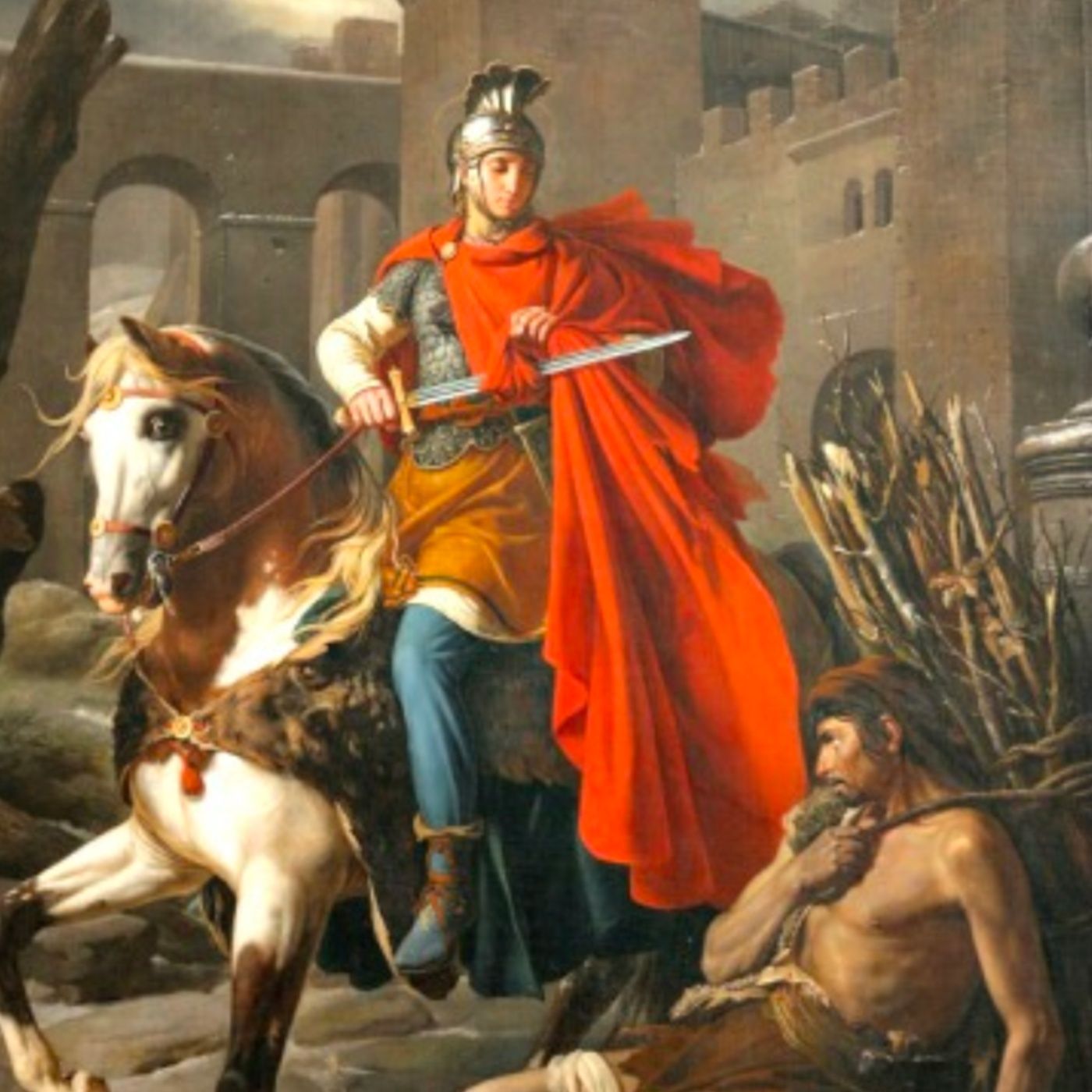
November 11: Saint Martin of Tours, Bishop
c. 336–397
Memorial; Liturgical Color: White
Patron Saint of France, soldiers, and conscientious objectors
He gave away half of his cloak and then all of his life
Many great and holy men and women are unknown to history because they lacked the one crucial ingredient to become well known—a biographer. Today’s saint was one of the fortunate ones. A historian named Sulpicius Severus personally knew and interviewed Martin in the last years of Martin’s life and put it all on parchment. In an age of few books, Sulpicius’ Life of Saint Martin was a blockbuster. Over many decades and centuries, it slipped into the bloodstream of European culture until, by the medieval age, the Life was standard reading in all monasteries. Virtually every priest and monk in Europe was deeply familiar with the details of the life of Saint Martin of Tours.
The typical biography of a saint for the first few centuries of Christianity worked from the back to the front, from death to life. The real drama was how the saint died, not how he or she lived. Tales of bloody martyrdom, solitary exile, starvation and exposure were as moving and unfortunate as they were common. The Life of Saint Martin told of Martin’s adventures and heroism in living the faith, not just about his last few breaths. He was a saint for the new age of legalized Christianity. Martin of Tours died in his bed.
Martin was born to pagan parents in present-day Hungary but desired to become a Christian from a young age. His father resisted his son’s holy desires and obliged Martin to follow in his footsteps and serve as a soldier in Rome’s Imperial Guard. Martin was serving in France when the most iconic moment of his life took place. Martin was slowly approaching the city gates of Amiens on horseback one cold winter evening. A half-naked man shivered on the ground, begging for help. No one stopped. No one helped. No one cared. So Martin, clad as a soldier, pulled the cloak from his back, drew his sharp sword from its scabbard, and sliced his cloak in two. The poor man’s skeletal frame was covered with just half of the cloak. That same night, when Martin fell asleep, he had a dream. Jesus appeared to him clad in the cloak and said “Martin, still a catechumen, covered me with this garment.” Upon awakening, Sulpicius tells his reader, “Martin flew to be baptized.”
Martin subsequently befriended one of the great men of Gaul of that era, Saint Hilary of Poitiers, who ordained him into minor orders. After various apostolic adventures, Martin was chosen the Bishop of Tours in 372. In his twenty-five years as bishop, Martin was zealous, and jealous, for the House of the Lord. He aggressively tore down pagan temples, which he understood to be dedicated to demons. He traveled incessantly and was untiring in evangelizing the people of the countryside of Gaul and in founding churches. Martin also developed a reputation as a miracle worker and prophet. He cured the eye problems of Saint Paulinus of Nola, Saint Augustine’s good friend.
By the time of his peaceful death, Bishop Martin of Tours had a well-deserved reputation for holiness. Devotion to Martin spread as Sulpicius’ biography was copied and shared. Numerous churches were named in Martin’s honor in every country of Europe. England had one hundred seventy-three churches dedicated to Martin of Tours in 1800. The Shrine over Martin’s tomb was one of the most popular pilgrimage destinations in all of Europe until France was riven by Reformation violence in the 1560s. In an interesting vestige of Martin’s enduring historic importance, Martin’s feast day in the Breviary is more fully elaborated with prayers and antiphons than almost any comparable saint on the Church’s calendar.
Saint Martin of Tours, your encounter with the beggar has fired the imagination of countless Christians. You were generous in every single way in living your faith. Through your intercession in heaven, assist us now to see Jesus in everyone, just as you did then.
view more
c. 336–397
Memorial; Liturgical Color: White
Patron Saint of France, soldiers, and conscientious objectors
He gave away half of his cloak and then all of his life
Many great and holy men and women are unknown to history because they lacked the one crucial ingredient to become well known—a biographer. Today’s saint was one of the fortunate ones. A historian named Sulpicius Severus personally knew and interviewed Martin in the last years of Martin’s life and put it all on parchment. In an age of few books, Sulpicius’ Life of Saint Martin was a blockbuster. Over many decades and centuries, it slipped into the bloodstream of European culture until, by the medieval age, the Life was standard reading in all monasteries. Virtually every priest and monk in Europe was deeply familiar with the details of the life of Saint Martin of Tours.
The typical biography of a saint for the first few centuries of Christianity worked from the back to the front, from death to life. The real drama was how the saint died, not how he or she lived. Tales of bloody martyrdom, solitary exile, starvation and exposure were as moving and unfortunate as they were common. The Life of Saint Martin told of Martin’s adventures and heroism in living the faith, not just about his last few breaths. He was a saint for the new age of legalized Christianity. Martin of Tours died in his bed.
Martin was born to pagan parents in present-day Hungary but desired to become a Christian from a young age. His father resisted his son’s holy desires and obliged Martin to follow in his footsteps and serve as a soldier in Rome’s Imperial Guard. Martin was serving in France when the most iconic moment of his life took place. Martin was slowly approaching the city gates of Amiens on horseback one cold winter evening. A half-naked man shivered on the ground, begging for help. No one stopped. No one helped. No one cared. So Martin, clad as a soldier, pulled the cloak from his back, drew his sharp sword from its scabbard, and sliced his cloak in two. The poor man’s skeletal frame was covered with just half of the cloak. That same night, when Martin fell asleep, he had a dream. Jesus appeared to him clad in the cloak and said “Martin, still a catechumen, covered me with this garment.” Upon awakening, Sulpicius tells his reader, “Martin flew to be baptized.”
Martin subsequently befriended one of the great men of Gaul of that era, Saint Hilary of Poitiers, who ordained him into minor orders. After various apostolic adventures, Martin was chosen the Bishop of Tours in 372. In his twenty-five years as bishop, Martin was zealous, and jealous, for the House of the Lord. He aggressively tore down pagan temples, which he understood to be dedicated to demons. He traveled incessantly and was untiring in evangelizing the people of the countryside of Gaul and in founding churches. Martin also developed a reputation as a miracle worker and prophet. He cured the eye problems of Saint Paulinus of Nola, Saint Augustine’s good friend.
By the time of his peaceful death, Bishop Martin of Tours had a well-deserved reputation for holiness. Devotion to Martin spread as Sulpicius’ biography was copied and shared. Numerous churches were named in Martin’s honor in every country of Europe. England had one hundred seventy-three churches dedicated to Martin of Tours in 1800. The Shrine over Martin’s tomb was one of the most popular pilgrimage destinations in all of Europe until France was riven by Reformation violence in the 1560s. In an interesting vestige of Martin’s enduring historic importance, Martin’s feast day in the Breviary is more fully elaborated with prayers and antiphons than almost any comparable saint on the Church’s calendar.
Saint Martin of Tours, your encounter with the beggar has fired the imagination of countless Christians. You were generous in every single way in living your faith. Through your intercession in heaven, assist us now to see Jesus in everyone, just as you did then.
More Episodes
November 4: Saint Charles Borromeo, Bishop
 2024-11-04
2024-11-04
 2024-11-04
2024-11-04
November 1: All Saints
 2024-10-29
2024-10-29
 2024-10-29
2024-10-29
October 28: Saints Simon and Jude, Apostles
 2024-10-24
2024-10-24
 2024-10-24
2024-10-24
October 23: Saint John of Capistrano, Priest
 2024-10-23
2024-10-23
 2024-10-23
2024-10-23
October 22: Saint John Paul II, Pope
 2024-10-22
2024-10-22
 2024-10-22
2024-10-22
October 18: Saint Luke, Evangelist
 2024-10-18
2024-10-18
 2024-10-18
2024-10-18
01345678910111213141516171819
Create your
podcast in
minutes
- Full-featured podcast site
- Unlimited storage and bandwidth
- Comprehensive podcast stats
- Distribute to Apple Podcasts, Spotify, and more
- Make money with your podcast
It is Free
- Privacy Policy
- Cookie Policy
- Terms of Use
- Consent Preferences
- Copyright © 2015-2024 Podbean.com






